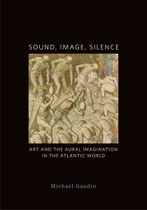Music Is a Aural Representation of Art Music Paints Silence
Audio, Image, Silence
Fine art and the Aural Imagination in the Atlantic Earth

MANIFOLD EDITION
A visionary new approach to the Americas during the age of colonization, made by engaging with the audible aspects of supposedly "silent" images
Sound, Epitome, Silence provides a groundbreaking examination of the colonial Americas past exploring the special role that aural imagination played in visible representations of the New Earth. It masterfully fuses a diversity of work beyond vast social, cultural, and spatial distances, giving united states both a new way of understanding sound in fine art and a powerful new vision of the New World.
"In this breathtaking study Michael Gaudio invites us to listen to visual media that seem couched in silence or in deceptive tranquility. He studies the graphic character of oral communication and trip the light fantastic toe in copperplate engravings of Jean de Léry'south come across with the New World; soundscapes of seventeenth-century paintings depicting Dutch holdings in Brazil; Enlightenment art depicting thunder and lightning; the vocalization of nature in American painting of the early 1800s; the audio of music in very early on movie theatre. Of broad scope, written with uncommon force and elegance, Sound, Paradigm, Silence inspires by virtue of a unique aural vision. It changes the direction of our appreciation of the visual arts."
—Tom Conley, Harvard University

Colonial depictions of the Northward and South American landscape and its ethnic inhabitants fundamentally transformed the European imagination—merely how did those images reach Europe, and how did they make their impact? In Audio, Paradigm, Silence, noted art historian Michael Gaudio provides a groundbreaking examination of the colonial Americas by exploring the special role that aural imagination played in visible representations of the New World.
Considering a diverse trunk of images that cover four hundred years of Atlantic history, Sound, Image, Silence addresses an important need within art history: to give hearing its due as a sense that can inform our understanding of images. Gaudio locates the racket of the infidel dance, the discord of battle, the din of revivalist religion, and the sublime sounds of nature in the Americas, such as lightning, thunder, and the waterfall. He invites readers to listen to visual media that seem deceptively couched in silence, offer bold new ideas on how fine art historians can engage with sound in inherently "mute" media.
Sound, Image, Silence includes readings of Brazilian landscapes by the Dutch painter Frans Mail, a London portrait of Benjamin Franklin, Thomas Edison'southward early Kinetoscope film Sioux Ghost Dance, and the work of Thomas Cole, founder of the Hudson River School of American mural painting. It masterfully fuses a diversity of piece of work across vast social, cultural, and spatial distances, giving united states both a new manner of understanding audio in art and a powerful new vision of the New World.

Michael Gaudio is professor of art history at the University of Minnesota, Twin Cities. He is author of Engraving the Savage: The New World and Techniques of Culture (Minnesota, 2008).

In this breathtaking study Michael Gaudio invites us to listen to visual media that seem couched in silence or in deceptive repose. He studies the graphic graphic symbol of spoken communication and dance in copperplate engravings of Jean de Léry'south encounter with the New World; soundscapes of seventeenth-century paintings depicting Dutch holdings in Brazil; Enlightenment art depicting thunder and lightning; the voice of nature in American painting of the early 1800s; the sound of music in very early movie theater. Of broad telescopic, written with uncommon force and elegance, Sound, Image, Silence inspires by virtue of a unique aural vision. Information technology changes the management of our appreciation of the visual arts.
—
Tom Conley, Harvard University
Sound, Epitome, Silence is a written report of how fine art making is a dance among sensorial pathways and homo run into. Michael Gaudio searches for interstitial meanings between many kinds of binaries in our cultures and histories—between what is heard and not heard, mimesis and invention, absorption and otherness. What results is an enthralling, crackling, heady journey into heretofore silent territories of artistic imagination.
—
Asma Naeem, Eddie C. and C. Sylvia Chocolate-brown Chief Curator, The Baltimore Museum of Fine art
One of the many claim of Gaudio's bracing volume is how it avoids positing sound as synonymous with speech, as a mere metaphor for how certain pictures "mean." Thus Sound, Image, Silence, in a refreshing way, moves us away from the indelible Derridian preference for différence every bit something written rather than heard.
With both optics and ears in sound studies, Michael Gaudio'southward clairaudience brilliantly achieves, in Sound, Paradigm, Silence, to tune in to that uncertain Atlantic passage, turning it on into a captivating journey between sight and sound.

Contents
Acknowledgments
Introduction
1. "Information technology Seems Their Voices Are Notwithstanding in My Ears": Picturing a Tupinambá Trip the light fantastic toe in 1592
2. Frans Post's Silent Landscapes
3. Magical Pictures, or, Observations on Lightning and Thunder, Occasion'd past a Portrait of Dr. Franklin
4. At the Mouth of the Cave: Listening to Thomas Cole's Kaaterskill Falls5. Dancing for the Kinetograph: The Lakota Ghost Dance and the Silence of Early Cinema
Coda
Notes
Index
Source: https://www.upress.umn.edu/book-division/books/sound-image-silence